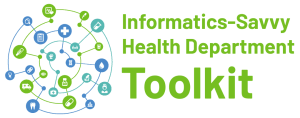
| Module 1 | Introduction |
Unit 1
|
|---|---|---|
| Module 2 | Making the case |
Unit 1
|
| Module 3 | Getting started |
Unit 1
|
| Module 4 | Self-assessment tools |
Unit 1
|
| Module 5 | Post-assessment resources |
Unit 1
|
| Module 6 | Supplemental resources |
Unit 1
|
| Module 7 | All toolkit downloads |
Unit 1
|
The informatics-savvy health department
Data and information have always been critical to the public health mission and operation. Receiving, managing, using and sending digital data, however, requires a level of informatics capabilities that many health departments are still struggling to define and build. This means that public health agencies need a clear informatics vision and strategy that includes workforce development and robust, interoperable information systems.
But first, what do we mean by “informatics” and an “informatics-savvy health department”? We define public health informatics as the discipline that supports the effective use of information and information technology to improve public health practice and population health outcomes. It is seen as critical to the future capability—and even credibility—of health departments.
We define an informatics-savvy health department as one which has three core elements:
- An overall vision and strategy for how it uses information and information technology as strategic assets.
- A skilled workforce.
- Well-designed and effectively used information systems.
By focusing on these three core elements, the self-assessment was developed to enable planning and priority setting to identify where your agency falls on a continuum. It will highlight current strengths upon which you can build, as well as areas that are candidates for improvement.
How to use this toolkit
This toolkit is divided into sections that will walk you through the assessment and post-assessment process:
- Making the case provides in-depth reading that can both inform your assessment activities and assist you in making the case to agency leadership that the assessment is needed and that strengthening your agency’s informatics capacity is not merely worthwhile, but crucial.
- Getting started serves as your starting point for understanding the self-assessment process, providing introductory materials to orient you. The facilitator companion guide will serve as your roadmap for conducting the assessment activities.
- Self-assessment tools house the actual tools that you will use to assess how informatics-savvy and interoperable your agency is in its current state.
- Post-assessment resources include guidance documents that will assist you in using your assessment results to inform ongoing informatics strategies.
- Supplemental resources include related toolkits, training and other resources that may be helpful to access, but are not core to the informatics-savvy toolkit.

